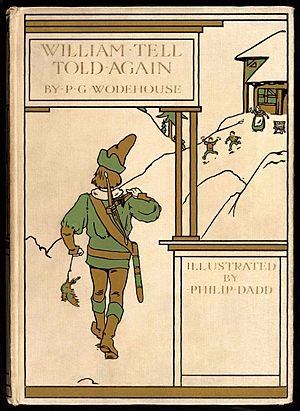William Tell Told Again facts for kids
William Tell Told Again is a fun book that retells the famous story of William Tell. It mixes regular writing (called prose) with poems. The book also has many colorful pictures.
The main story was written by P. G. Wodehouse. The beautiful pictures were drawn by Philip Dadd. There are 15 full-page illustrations. Each picture has a short poem written by John W. Houghton. He also wrote the opening and closing poems for the book.
This book came out on November 11, 1904. It was published by Adam & Charles Black in London. P. G. Wodehouse dedicated the book to "Biddy O'Sullivan." For a long time, no one knew who Biddy was. In 2006, people found out she was the young daughter of Denis O'Sullivan. He was an actor and a friend of Wodehouse.
Contents
The Story of William Tell
The book starts with a poem that explains the story. It says that the Swiss people needed a leader. They were fighting against their Austrian rulers. William Tell helped them gain their freedom.
Switzerland Under Austrian Rule
The story takes place a long time ago. Switzerland was controlled by the Emperor of Austria. The Emperor's friend, Hermann Gessler, was the Governor. Gessler was a very strict ruler. He made the Swiss people pay very high taxes.
The people were unhappy about the taxes. Three men, Walter Fürst, Werner Staufacher, and Arnold of Melchthal, went to Gessler. They wanted to complain about the unfair taxes. Gessler refused to change anything. He even threatened them to make them leave.
William Tell Becomes a Leader
The townspeople decided to fight back. They wanted William Tell to be their leader. Tell was known for being brave and loving his country. He was also very good with a crossbow.
The three men went to Tell's house. Tell lived with his wife, Hedwig, and their sons, Walter and William. Tell was not a great speaker. He didn't want to be a leader. But he agreed to help if they needed him.
Gessler's Strange Rule
Gessler liked to annoy the Swiss people. He had already banned games, dancing, and singing. He needed a new idea. He decided to put a pole in a meadow outside town. He placed his old hat on top of it.
Everyone had to bow to the hat when they passed by. If someone didn't bow, they would be arrested. Two soldiers, Friesshardt and Leuthold, watched the pole. People gathered far away to throw things at the guards.
Tell's Defiance
William Tell and his son Walter didn't know about the hat. They walked across the meadow without bowing. The soldiers told Tell to bow, but he kept walking. Friesshardt hit Tell on the head.
Tell fought back, and the crowd joined in. But Tell thought it was unfair for a crowd to fight two men. So, he shot the hat off the pole with his crossbow. The fighting stopped, and the people cheered.
The Apple Shot
Gessler arrived with his armed guards. The townspeople ran away. The soldiers told Gessler what happened. Gessler already disliked Tell. He was angry that Tell shot his hat.
Walter, Tell's son, said his father could hit an apple from far away. Gessler then ordered Tell to shoot an apple off his son's head. If Tell refused, both he and his son would die. Tell didn't want to do it, but Gessler insisted.
The crowd came back to watch. Walter was sure his father would make the shot. Tell took two arrows. He put one in his belt. He shot the first arrow, and it hit the apple. The crowd cheered loudly.
Gessler asked why Tell had a second arrow. Tell explained that if he had hit his son, he would have shot Gessler with the second arrow. Gessler was furious. He had Tell arrested. Tell was to be taken to Gessler's castle across the lake.
Escape and Freedom
On the lake, a big storm hit the ship. The helmsman couldn't steer the ship. Gessler ordered Tell to steer. Tell guided the ship through dangerous rocks and saved everyone.
When Gessler told the guards to tie him up again, Tell grabbed his bow. He jumped off the ship onto the rocks. Gessler told his archers to shoot Tell. But Tell was faster. He shot Gessler with his second arrow, killing him.
With Gessler dead, the Swiss people were no longer afraid. They successfully fought against Austrian rule. Some people wanted to burn Gessler's pole. But Tell decided to keep it. It would be a reminder of their new freedom. Tell went home and lived happily with his family.
Book Style
P. G. Wodehouse wrote the story in a funny way. It makes fun of how old stories are often retold. The book follows the main parts of the William Tell legend. But it changes some details to make them silly and funny.
The language in the book sounds a bit old-fashioned. It's like the formal way some children's stories used to be written. Wodehouse also used funny writing tricks that he would use in his later books.
For example, Tell uses a mixed-up saying: "'Gentlemen,' continued Tell, 'the flood-gates of revolution have been opened. From this day they will stalk through the land burning to ashes the slough of oppression which our tyrant Governor has erected in our midst." This mixes ideas in a humorous way.
Another funny trick Wodehouse used was listing things that don't quite fit together. For example, when describing Tell, the book says: "He had the courage of a lion, the sure-footedness of a wild goat, the agility of a squirrel, and a beautiful beard." The "beautiful beard" is a funny addition to the list of brave qualities.


